Exploring the Depths of Longboarding Culture and Techniques
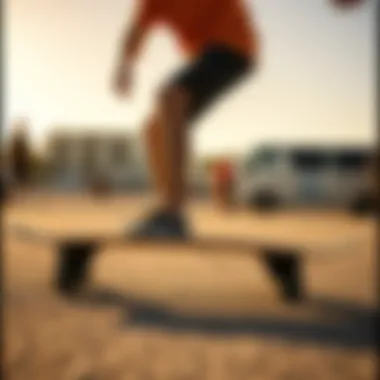
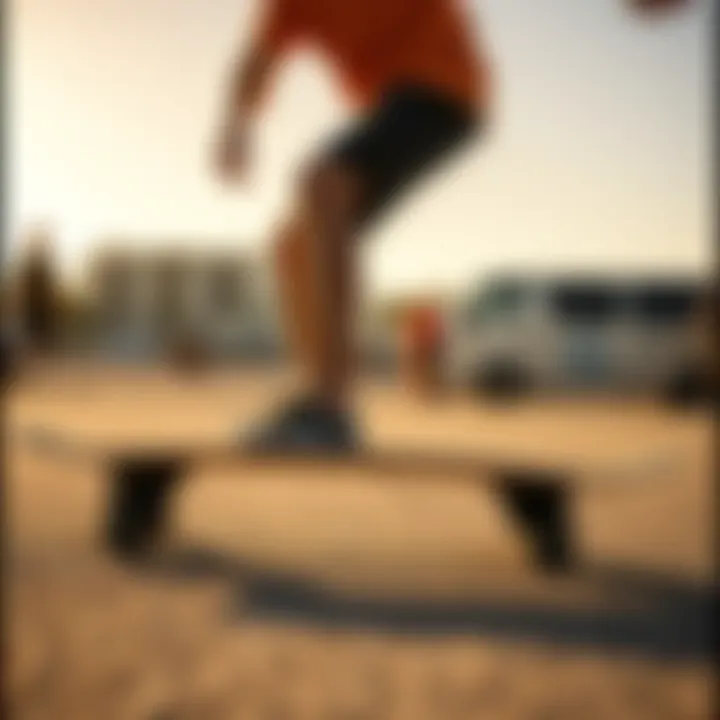
Intro
Longboarding has carved a niche in the world of skate sports, blending artistry and engineering in a way that attracts both young and old alike. As a longboarder skates down a sunny hill, the wind whipping through their hair, there's an unspoken understanding that this sport isn’t just about the ride; it’s a lifestyle, an art form, and a science all rolled into one. For those interested, longboarding is much more than a pastime; it’s an avenue for self-expression, where every turn and slide tells a story of adventure and skill.
In this comprehensive guide, we journey through the essentials of longboarding, exploring its rich history, various styles, and the gear that has become synonymous with the sport. Whether you're new to this cinematic experience or you’ve been riding for years, there's something to gain here.
Let's break down the pivotal elements of longboarding, revealing not only the techniques and skills required but also the latest gear technology that can enhance every rider's experience.
Gear and Equipment
Gear and equipment are to longboarding what brush and canvas are to an artist. Choosing the right setup can dramatically affect your performance, technique, and safety.
Longboard Types
There’s an array of longboards to suit varied styles and purposes. Here are some common types:
- Cruisers: Versatile boards perfect for casual rides and commutes.
- Downhill Boards: Designed for high-speed descents, featuring a lower center of gravity.
- Freestyle Boards: Great for performing tricks, often shorter and more flexible.
- Carving Boards: Built for making quick turns and carving up the pavement, enhancing those surfing vibes.
Understanding which type fits your style can help maximize your enjoyment and skill progression.
Latest Longboard Technologies
Longboarding has evolved thanks to innovations in materials and design. Today, you’ll find:
- Composite Decks: Using a mix of materials like bamboo and fiberglass, these decks are lightweight but durable.
- Precision Trucks: These allow for increased turning ability and stability, crucial for handling high speeds.
- High-Performance Wheels: Made from urethane, they provide better grip and a smoother ride.
As technology advances, many manufacturers focus on reducing weight while enhancing durability, ensuring a smoother ride that can tackle various terrains.
Essential Accessories for Every Longboarder
Beyond the board itself, certain accessories are essential for every serious rider:
- Helmets: Safety first! A good helmet can prevent serious injuries.
- Protective Padding: Wrist guards, knee pads, and elbow pads can help avoid those nasty scrapes.
- Riding Shoes: Footwear designed for grip and comfort is key for maintaining control and maneuverability.
Investing in quality equipment and accessories not only enhances performance but significantly contributes to safety, allowing longer, more enjoyable rides.
"Safety isn't just a priority; it should be a lifestyle choice for every longboard enthusiast."
With proper gear and understanding the various types and their functions, riders can improve their skills. Longboarding invites exploration and creativity, all while savoring the thrill of carving through landscapes. Join us as we delve deeper into techniques and skills next.
Preamble to Longboarding
Longboarding isn’t merely a sport; it’s an experience, a culture, and a means of expression for many enthusiasts across the globe. Understanding the intricacies of longboarding is essential—not just for mastering the art of riding but also for fully appreciating its rich heritage. This section aims to lay the groundwork by examining what longboarding truly is, how it originated, and how it has evolved over the decades.
Definition and Origin
At its core, longboarding can be thought of as a derivative of skateboarding. However, the two diverge significantly in terms of design and purpose. While skateboards are typically shorter and geared toward tricks, longboards are longer and designed for stability and ease of cruising. The length often exceeds 35 inches, allowing for a smoother ride, especially on downhill runs.
The roots of longboarding stretch back to the 1950s in California when surfers wanted to mimic the feeling of riding waves on land. They began to attach wheels to wooden boards, and thus the first longboards were born, serving as both a mode of transportation and a fun diversion.
Evolution Over the Years
Longboarding has metamorphosed from a simple pastime into a thriving sport, undergoing several transformations along the way. Initially, longboards were hand-crafted from whatever wood was available, generally bulky and heavy. Today, the options are vast, with materials like bamboo and fiberglass dominating the market for their lightweight and flexible qualities.
In the 1970s and 1980s, the sport saw a rise in popularity, leading to more types and variations of longboards designed for diverse styles of riding—whether it's cruising, downhill racing, or freestyling. Fast forward to the present, the internet has played a significant role in the development and community engagement surrounding longboarding. With platforms like Reddit and various social media outlets, riders can share tips, tricks, and experiences, fostering a global community that supports newcomers and seasoned riders alike.
As longboarding continues to grow, the cultural aspects remain just as crucial as the technicalities. There are longboarding festivals, races, and even competitive events where riders showcase their skills. It’s about more than simply balancing on a board; it’s about camaraderie, freedom, and a lifestyle embraced by many.
Equipped with this understanding of longboarding's definition and evolution, enthusiasts can better appreciate the layers of complexity it offers—whether that’s for personal enjoyment or competitive prowess. As we move forward in this article, we'll unravel the diverse types of longboards, essential gear, and the skills required to thrive within this captivating sport.
Types of Longboards
Longboarding is not just a hobby; it’s a lifestyle that adapts to various terrains and riding preferences. This versatility has led to the development of several types of longboards, each with its own unique features and ideal applications. Understanding the different categories can help riders make informed choices based on their skill levels, preferred riding styles, and safety considerations. Whether one is commuting, carving down hills, or engaging in freestyle tricks, selecting the right longboard is crucial for an enjoyable experience.
Cruisers
Cruiser longboards are often seen as the workhorses for casual rides. Their design is geared towards ease of use and comfort, making them an excellent choice for beginners and those looking to cruise around town. These boards are typically lightweight and feature a wider deck, allowing for a relaxed stance while riding.
The wheels on cruisers tend to be softer, meaning they absorb bumps well, making them perfect for rough terrain or city streets. They excel at turning and maneuvering through traffic, making them suitable for both leisurely rides in the park and short commutes. The aesthetic appeal of many cruisers also attracts riders who value style as much as functionality. Some popular cruiser models include the Landyachtz Dinghy or the Globe Blazer.
"A cruiser longboard is like a trusty companion; it’s there for both everyday errands and spontaneous adventures."

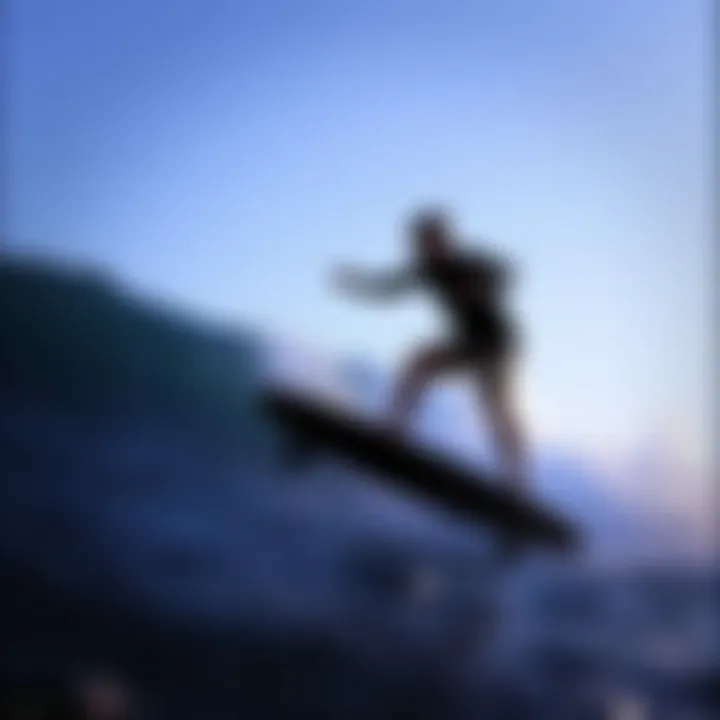
Downhill Boards
Downhill longboarding is where the thrill-seekers truly find their element. Designed for speed and stability, these boards boast a lower center of gravity and a longer wheelbase, which helps maintain balance at higher velocities. Riders looking to challenge themselves with steep descents will appreciate the performance of downhill boards.
Typically constructed with durable materials designed to withstand high impacts, these longboards often come with stiffer flex settings to provide better response during aggressive maneuvers. This type includes features like drop-through trucks which lower the rider’s center of gravity even more, resulting in increased control when tackling those sharp curves. Some notable brands like Sector 9 and Rayne offer exceptional downhill boards tailored for maximum performance.
Freestyle Longboards
Freestyle longboarding combines tricks, flips, and creativity on the board. Riders can perform a wide array of maneuvers, translating into a dynamic and expressive form of riding. These longboards are usually symmetrical, allowing for riding in either direction, which caters to skate-centric trick execution.
Freestyle boards typically have a smaller footprint, making them lighter and easier to spin. The flexibility in the deck helps riders absorb shocks from tricks, thereby reducing fatigue during sessions. Riders use them for everything from ollies to shuvits, making them perfect for those who want to showcase their skills. Brands such as Loaded Boards offer quality options for freestyle enthusiasts.
Sliding Boards
Sliding boards are a specific type geared primarily towards, you guessed it, sliding. Sliding is a thrilling technique where riders intentionally lose traction to create a controlled skid, which is particularly useful in downhill riding. This type of board is designed with specialized wheels and often features a more concave shape to allow for enhanced foot placement stability.
The setup encourages a mix of fun and control, helping riders to master their sliding skills. Riders often favor using harder durometer wheels to create a smoother slide experience. A few examples that cater to this niche include the 40-Inch Arbor Axis and the Landyachtz 40" Drop Hammer. A dedicated sliding board significantly improves a rider's ability to control their speed, heightening safety during high-speed descents.
Key Components of a Longboard
Understanding the key components of a longboard is crucial for anyone looking to delve into this sport, whether you are a novice or an experienced rider. The choice of materials and the design of these components can dramatically influence riding experience, stability, speed, and safety. A well-rounded knowledge of these elements not only enhances performance but also helps in selecting the best board suited to individual riding styles and conditions.
Deck Types and Materials
The deck is the heart of the longboard, as it serves as the surface where riders stand. Longboard decks come in a variety of shapes and sizes, influenced by the style of riding and personal preferences. Common types of longboard decks include:
- Drop-through: This deck style lowers the rider's center of gravity, making it ideal for downhill racing and cruising.
- Drop deck: Similar to drop-through, this deck has a concave shape that sits close to the ground, enhancing stability when carving.
- Kicktails: Boards with kicktails allow riders to maneuver and pivot easily, making them great for tricks and street riding.
Materials play a vital role in the durability and flexibility of the deck. While some boards might use bamboo for its lightweight and resilient nature, others may rely on maple or fiberglass for sturdiness. Composite materials are also popular for high-end boards, offering a blend of strength and flexibility. The choice of material significantly affects how the board responds to your movements. For instance, a flexible board is great for absorbing shocks from rough terrain, while a stiffer board can provide more control and speed on smoother surfaces.
Trucks and Their Functionality
Trucks might seem like simple components, but they are the unsung heroes of a longboard, affecting how a rider navigates turns and balances on the board. They come in two primary types: traditional and reverse kingpin trucks. Traditional trucks are more straightforward in design and can be easier to tweak for beginners. In contrast, reverse kingpin trucks offer greater maneuverability and stability at higher speeds, which is ideal for downhill riders.
These components also have adjustable features that influence turning radius. A tighter turning radius is beneficial for navigating crowded streets, while wider settings provide more stability for high-speed descents. Other aspects to consider include the width of the trucks, which should correspond to the width of the deck for optimal performance. Paying attention to hardware like bolts and washers is also key, as they can affect maintenance and longevity.
Wheels: Size and Hardness
Wheels, like the tires on a car, play an essential role in how your longboard handles. They come in various sizes and hardness ratings, impacting ride quality significantly. Typically, longboard wheels can range from 55mm to 80mm.
- Larger Wheels: Better suited for downhill rides and rough terrains as they can roll over obstacles more easily.
- Smaller Wheels: Provide a smooth ride on flat surfaces, often favored for tricks and skate parks.
When it comes to hardness, the durometer scale is the standard measure. Softer wheels (78A-83A) allow for a smoother ride, absorbing bumps along the road. However, they might wear out faster if used on rough surfaces. On the contrary, harder wheels (84A and up) can slide more easily but may deliver a harsher ride on uneven ground.
Choosing the right combination of wheel size and hardness depends on your riding style and terrain. Each type has its own advantages and disadvantages, making it essential to consider what feels right beneath your feet.
"The right equipment can make a world of difference. Understanding each component helps riders to choose wisely and ride safely, ultimately improving their experience on the board."
Safety Precautions
Engaging in longboarding isn't just about mastering tricks or cruising down hills; it’s about safety as well. Prioritizing safety precautions can mean the difference between an unforgettable ride and a trip to the emergency room. Let's delve into the essentials to keep riders safe.
Essential Protective Gear
When it comes to gear, don’t skimp out. It might feel cumbersome, but wearing protective equipment is essential for anyone hitting the pavement, especially newbies. Here’s a rundown of gear every longboard rider should consider:
- Helmet: A must-have. Look for a well-fitting model, ideally ANSI or CPSC certified. Your noggin deserves the best!
- Wrist Guards: These can save your wrists when you take a spill, which is bound to happen if you're learning new techniques.
- Knee and Elbow Pads: Protect those joints! They are simple but highly effective in cushioning falls.
- Closed-toe Shoes: Footwear matters. Opt for shoes with good grip and that cover your toes. Flip-flops won’t cut it here.
Using this gear doesn’t just protect; it builds confidence by instilling a sense of security while riding.
Understanding Riding Conditions
Longboarding can be greatly influenced by environmental factors. Knowing the terrain and prevailing conditions is crucial to a safe ride. Here’s what to keep in mind:
- Terrain: Is it smooth, rough, or scattered with debris? A smooth asphalt path is much safer than a gravelly surface. If your board skips over a pebble, you could be kissing the ground before you know it.
- Weather: Riding in wet conditions is a recipe for disaster. Rain creates slick surfaces that increase your chances of slipping.
- Time of Day: Daylight is your friend. Riding at night can impair visibility. If you must ride late, consider reflective gear or lights to ensure others see you.
Safety Reminder: Before heading out, always assess the conditions. If they seem dicey, it's better to postpone your ride.
By keeping these precautions at the forefront of your riding practice, the joy of longboarding can be truly appreciated. After all, skating should highlight freedom and expression, not be marred by unnecessary mishaps. Following these guidelines will enable riders to experience the thrill while reducing risks, allowing for a safer adventure on the open roads.
For more on safety protocols, check out Centers for Disease Control and Prevention and National Highway Traffic Safety Administration.
Fundamental Skills for Beginners
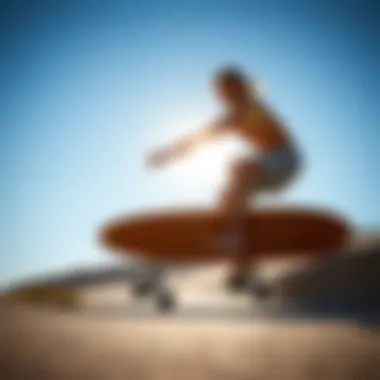
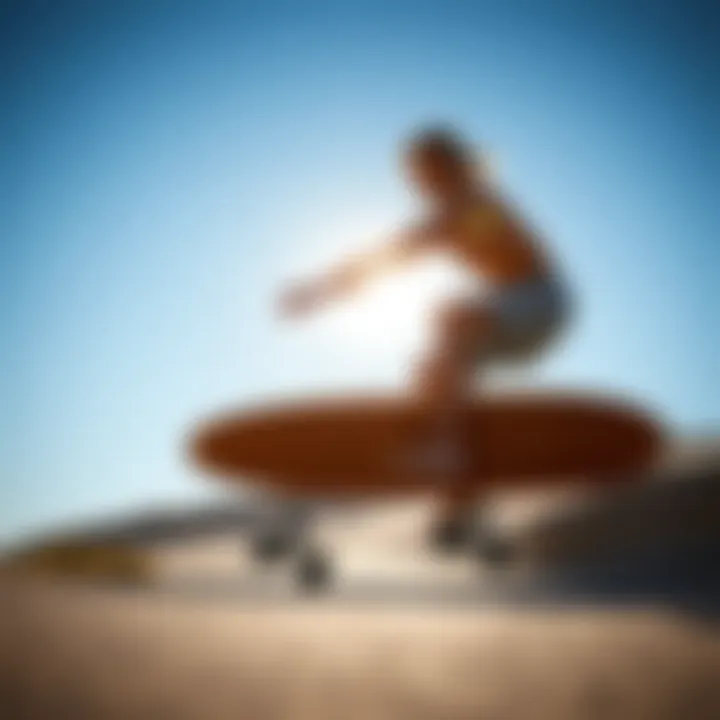
Longboarding is not just a thrilling ride; it is also an engaging pursuit that demands specific skills, especially for those who are just getting started. Understanding and mastering the fundamental techniques can make the journey smoother and more enjoyable. These essential skills lay the groundwork for safe riding, effective control, and greater confidence. For beginners, familiarizing oneself with the basics isn’t just a suggestion; it’s central to ensuring a fulfilling longboarding experience that can build towards more advanced tricks and styles.
Balancing Techniques
Balancing while on a longboard is much like finding your footing on a tightrope; one misstep, and you could be headed for a tumble. To grip this aspect effectively, it is crucial to adopt a few basic stances. The most common are the regular stance (left foot forward) and goofy stance (right foot forward).
- Practice standing still: Find a flat area, place your foot just above the rear wheels, and rest your other foot on the board's front. Shift your weight gently from foot to foot. This helps develop a sense of balance.
- Knees bent: A low center of gravity is beneficial. Bent knees make it easier to maintain stability, especially when riding downhill.
- Engage your core: Keeping your core muscles engaged will help maintain balance and give you better control over direction changes.
"Balance may not be the most glamorous skill, but it’s the foundation on which all your future riding prowess will be built."
Pushing and Stopping
Once you’ve got your balance down, moving forward is the next challenge. Pushing off is a fundamental skill that defines your speed and smoothness on a longboard. Here's how to do it:
- Pushing off: Start with your back foot on the tail of the board and push with your front foot on the ground. Gradually transition your weight back onto the board after each push.
- Keep the motion fluid: Your pushes should come in rhythm, allowing you to gain momentum without feeling jerky.
- Stopping safely: The simplest method for halting is the foot brake. Place your back foot on the ground while keeping your front foot on the board.
Here are additional stopping techniques:
- Heel drag: Drag your heel along the ground, giving you friction to slow down.
- Carving: Shift your weight from side to side. It’s effective for slowing down on gentle slopes.
Turning Principles
Navigating turns on a longboard is akin to steering a ship. It requires finesse, timing, and awareness of your surroundings.
- Lean into the turn: As you approach a turn, shift your weight towards the direction you wish to go. This motion engages the board��’s flexibility, allowing sharper turns.
- Carving turns: Carving is a process that involves making wide, rhythmic turns while maintaining speed. It’s fabulous for controlling your velocity and adds flow to your ride.
- Practice wider turns first: Start with broad arcs to become comfortable before moving on to tighter turns.
Longboarding isn’t merely about dancing in the breeze; it's a spectacular blend of art and science. Incorporating these fundamental skills paves the way for safer, more enjoyable rides, embracing both the freedom of the board and the responsibility that comes with it. For avid surfers, outdoor enthusiasts, and travel bloggers alike, honing these skills becomes part of the journey to greater mastery in the world of longboarding.
Advanced Techniques
Mastering advanced techniques in longboarding is a rite of passage for many riders. These skills can elevate your riding experience and open up a new dimension of enjoyment and control on the board. Not only do they enhance your overall agility, but they also provide practical benefits for tackling diverse conditions and terrain.
Carving and Drifting
Carving involves making smooth, controlled turns down a hill or along pathways, utilizing your body weight and the board's design. This technique can help you maintain speed while allowing you to manipulate your direction effectively. Drifting, on the other hand, is often seen as a way to slide sideways while maintaining enough momentum. Both skills share a foundation in balance and body positioning.
Practicing carving helps build muscle memory and control in your ride. It mimics the flow of surfing or snowboarding, but on asphalt. For example, when carving, your knees bend as you lean into the turn, and you’ll find a rhythm that feels natural. The more you practice, the more fluid your movements become.
Drifting is equally thrilling but requires precise timing and an understanding of your board’s dynamics. As you start to slide, maintaining grip requires shifting your weight carefully and finding that sweet spot. Slowly easing into longer drifts can be ideal. A helpful tip is to practice on gentle hills before tackling steeper slopes.
Power Sliding Skills
Power sliding takes drifting to the next level. It’s a technique used by many riders to slow down quickly without any extra braking equipment. Instead, it relies on the rider’s skill to shift their body weight properly and initiate a slide. This skill is great not just for stopping but also for maintaining speed during sharp turns.
Learning to power slide can be invigorating yet challenging. You start with just a gentle push and gradually lean into the slide, using your back foot to manipulate the board. Gradually, your confidence will grow, allowing you to take on other challenging techniques.
While mastering this technique, keep an eye on your surroundings. Look out for road surfaces that may affect your grip. A smooth surface is often welcoming for sliding, but a bumpy road can lead to unexpected jolts.
Freestyle Tricks
Freestyle tricks bring an artistic flair to longboarding, blending creativity and skill into a unique form of expression. These tricks can range from simple maneuvers like shuvits to more complex ones like flips and spins. Engaging in freestyle riding allows you to customize your style, giving you the chance to make your board truly yours.
Advanced riders often incorporate freestyle tricks into their routine, pushing the limits of what’s possible on a longboard. If you’re looking to start, begin with foundational tricks. Once you’re comfortable, you can start creatively combining moves.
Practicing regularly is crucial, so be patient with yourself. Finding an open space free of obstruction is vital to build your confidence without stressing about collisions. Additionally, consider documenting your progress. Filming your attempts can provide you insights into your technique and improve your skills.
"The beauty of longboarding lies in its ability to fuse athleticism and artistry. Freestyle tricks offer a personal touch that defines the rider's style."
In summary, advanced techniques in longboarding not only enhance your skills but also enrich your experience. Carving and drifting offer control and style, while power sliding provides crucial braking ability. Freestyle tricks allow for creative expression, making every ride unique. By engaging with these advanced skills, riders can explore deeper dimensions of this exhilarating sport.
Terrain and Conditions
Understanding terrain and conditions is essential for any longboarder looking to fully enjoy the sport. Longboarding isn't just about balancing on a board; it's about navigating diverse landscapes and adapting to various environments. The terrain you choose to ride on can significantly influence your riding experience, safety, and overall skills development.
Riding on smooth, flat surfaces like basketball courts or well-paved roads allows for easy gliding and practice of basic techniques. On the other hand, uneven pathways or steep hills present their own set of challenges, requiring a different skill set and mindset. Knowing what type of terrain suits your current skill level can help in honing your abilities and ensuring safety at the same time.
Ideal Riding Locations
Ideal riding locations for longboarding can vary greatly depending on your skill level and personal preferences. Here’s a breakdown of various popular spots:
- Parks and Plazas: Great for beginners, these places often have flat and wide spaces, ideal for practicing pushing or turning. Parks tend to have smooth surfaces, making it enjoyable for anyone starting out.
- Boardwalks: These often provide picturesque views while being safe and smooth. Long boardwalks tend to be crowded, but the scenery can make it worthwhile. Just watch for pedestrians!
- Hilly Areas: For advanced riders, hills can offer the thrill of downhill speeds. Locations with steep inclines require good braking techniques, but they offer exhilarating rides that are hard to match.
- Paved Trails: Many towns have paved biking or walking trails. These can be excellent for uninterrupted rides while being mentally easier than riding on the road with traffic.
Choosing an ideal location not only enhances your riding experience but also helps in mastering new skills without unnecessary risks. As a longboarder, you seek out spots that challenge and inspire you while respecting the surrounding environment.
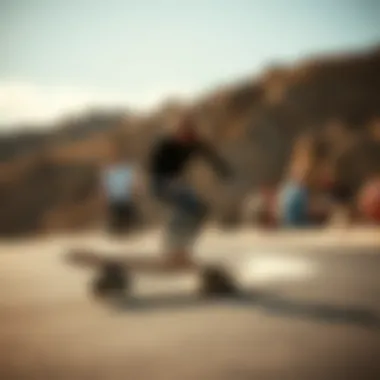
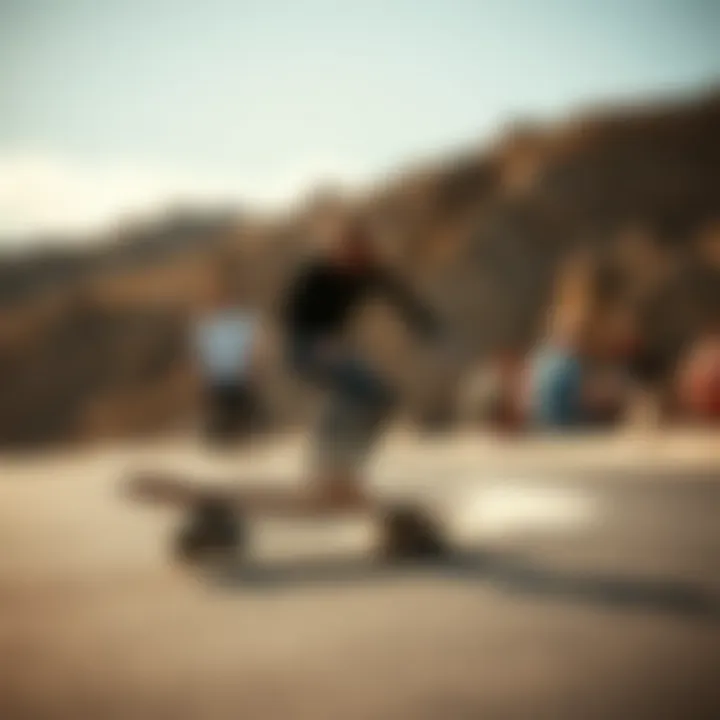
Adapting to Weather Influences
Weather influences your longboarding experience in ways that can either enhance or hinder it. Being able to adapt to weather conditions is a key skill for any rider:
- Sunshine: Clear skies and warm weather generally lead to the best riding experiences. However, don’t forget to stay hydrated and wear appropriate sunscreen. Exposure to sunlight can lead to fatigue during long sessions.
- Rain: Wet roads can be a nightmare for longboarders. Slipping is a considerable risk; therefore, choosing not to ride in the rain or only practicing basic balance exercises could be wiser. If you do venture out, consider using wheels designed for wet conditions.
- Wind: Breezy days can affect your downhills, but can also provide a unique challenge. Learning how to ride in windy conditions can improve balance and control. Pro tip: Riding with the wind at your back can help during uphill climbs.
- Temperature: Cold weather might make it less enjoyable to ride. Cold and stiff muscles can lead to injuries. Dress in layers and choose lower impact rides if you're out in cooler temperatures.
Understanding how these conditions affect your ride can make a world of difference in your overall performance. Always evaluate the environment before stepping out.
"Riding isn't just about the board; it's about how you relate to everything around you."
Each longboarder develops their unique approach to terrain and conditions, which adds depth to the sport. Pay attention to what the environment presents, embrace the challenges, and your journey in longboarding will be all the more rewarding.
For further insights on terrain adaptabilities in sports, check out segments on Wikipedia Terrain Analysis in Sports or join discussions on Reddit Longboarding Community.
Actual experiences contribute to knowledge, so engage with local longboarding groups on platforms like Facebook or join meetups in your area.
Maintenance of Longboards
Keeping a longboard in top shape is crucial for longevity and performance. Neglecting maintenance can lead to various issues that compromise safety and hinder the riding experience. A well-maintained longboard is not only more enjoyable to ride, but it also ensures that the rider remains safe while navigating different terrains and conditions. Understanding the various components of a longboard and the role they play in overall functionality is vital.
In this section, we delve into the routine checks and adjustments that every longboarder should carry out, as well as how to identify when it's time to replace worn-out parts.
Routine Checks and Adjustments
Just like a vehicle, your longboard requires routine checks to function optimally. Here’s what you should keep an eye on:
- Deck Integrity: Inspect the deck for any cracks, splinters, or warping. A compromised deck can severely affect stability and can be a disaster waiting to happen.
- Trucks Alignment: Check if the trucks are aligned properly. Misaligned trucks can cause uneven wear and make turning difficult.
- Wheel Condition: Examine wheels for flat spots, cracks, and wear. Investing in a good set of wheels can make a world of difference in your ride.
- Bearing Maintenance: Clean and lubricate bearings as needed. Dirty or rusty bearings lead to sluggish performance.
Setting a schedule for these routine checks—perhaps every couple of weeks—will keep you aware of your board's condition and help in catching potential issues early. It is advisable to also clean your board after riding in wet or dirty conditions, as moisture can contribute to rust in components like the bearings.
Replacing Worn Out Parts
Even with the proper maintenance, parts will eventually wear out and need replacing. Knowing when and how to replace these parts is key to keeping your board in working condition. Here’s what you should consider:
- Wheels: If you notice a significant loss of grip or if the wheels feel squared off, it’s time to replace them. Remember, using the right wheel hardness for your riding style can enhance performance significantly. Softer wheels grip better on rough surfaces, while harder wheels roll smoother on smooth pavements.
- Trucks: When trucks start to feel loose or require constant tightening, they may be worn out. Look for any visible damage; if worn, replace them with similar ones that suit your riding style.
- Bearings: If you hear grinding noises while riding or if the wheels don't spin freely, it might be time for new bearings. Top-quality bearings, when properly maintained, can up your speed immensely.
Community and Culture
The community surrounding longboarding is not just a group of riders; it's a vibrant tapestry woven with passion, camaraderie, and a shared love for the sport. This collective spirit plays a crucial role in the ongoing evolution and popularization of longboarding. By bringing together diverse individuals, the longboard community offers a space where enthusiasts can share tips, showcase their skills, and bond over experiences on wheels.
A significant part of this culture is fueled by the digital age, particularly through social media. Platforms such as Instagram and TikTok have become virtual skate parks where riders display their tricks, gear, and favorite spots, inspiring others and forging connections across the globe.
The Role of Social Media
Social media is a double-edged sword; it can either entrap or liberate, depending on how it’s used. Within the longboarding community, these platforms provide a stage for riders to not only flaunt their skills but also share valuable insights and advice that transcend geographic boundaries. For instance, a rookie in a bustling city might follow expert riders who offer tips on maneuvering through tight spaces, while those in quieter regions can discover a world of longboarding styles beyond their local scene.
Social media groups and forums also serve as lifelines for many. These digital meeting points allow longboarders to connect, organize meet-ups, and exchange gear recommendations. Hashtags related to longboarding — such as #LongboardLife, #DownhillRiders, and #FreestyleLongboarding — create a sense of unity amongst diverse riders, regardless of their backgrounds. Moreover, this interconnectedness promotes inclusivity, inviting newcomers into the community with open arms and encouraging them to participate.
As the adage goes, "Birds of a feather flock together," and social media exemplifies this in the longboarding world. It nurtures relationships, celebrates local scenes, and has turned casual riders into influencers, encouraging a more robust culture.
Global Longboarding Events
Global longboarding events are the heartbeat of this culture, bringing riders from all corners of the planet together for competition and celebration. One of the most recognized gatherings is the International Downhill Federation (IDF) World Championship. Riders push their limits while carving down hills, competing against the best in the sport. Such events are not just about racing; they embody a spirit of friendship and unity that reveals the soul of longboarding.
It’s worth noting how these gatherings foster not only competition but also learning opportunities. Workshops and demonstrations provide an avenue for riders to learn from seasoned pros. Classes on advanced techniques, safety, and maintenance are often offered, enriching the community's overall knowledge base.
In addition to competitions, longboarding festivals celebrate the culture itself — music, art, and skateboarding combine into exhilarating experiences. Events like the Venice Longboard Festival, with its aesthetic of sun-kissed coastal vibes, offer a chance for riders to mingle, share stories, and partake in activities that solidify friendships beyond the pavement.
To keep up with longboarding events or participate in community discussions, platforms such as Reddit or Facebook can be invaluable resources. Here, riders exchange advice on upcoming contests, provide travel tips, and create a buzz around events that keep the spirit of longboarding alive and kicking.
"Longboarding is not just a sport; it's a lifestyle that connects people across continents."
Closure
When wrapping up our exploration of longboarding, it’s clear that this sport intertwines art and science in a unique and compelling manner. Longboarding isn’t just about riding; it’s a sophisticated blend of technique, style, and community. The various types of longboards—from cruisers to downhill boards—each serve distinct purposes and cater to different riding preferences, which showcases the versatility of the sport.
The Future of Longboarding
Looking ahead, the future of longboarding seems both promising and exciting. Innovations in technology are pushing the boundaries of what riders can achieve. For instance, manufacturers are experimenting with new materials that enhance durability and performance, allowing for longer stints on the pavement without the usual wear and tear. It’s not uncommon to see boards that adapt to various terrains, thanks to evolving wheel designs.
Moreover, the community aspect of longboarding is thriving, especially with social media amplifying voices that were once low-key. Platforms like Instagram and Reddit are brimming with stunning visuals and tips that foster a global culture of sharing knowledge and skills. Riders are now more connected than ever, regardless of geographical boundaries.
The essence of longboarding transcends the physical act; it's about connecting with community and pushing the limits.
In addition, environmental considerations have spurred initiatives promoting sustainable materials and eco-friendly practices within the longboarding community. Riders are becoming increasingly conscious of their impact on the environment, seeking products that align with their values, which is a trend that's likely to grow in importance.
For more insights and information on longboarding, consider checking out Wikipedia or engaging with communities on Facebook and Reddit.
This comprehensive consideration of the culture, skills, and forward momentum of longboarding serves as a gateway to understanding not just a sport, but a lifestyle that offers endless possibilities.







